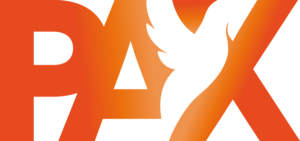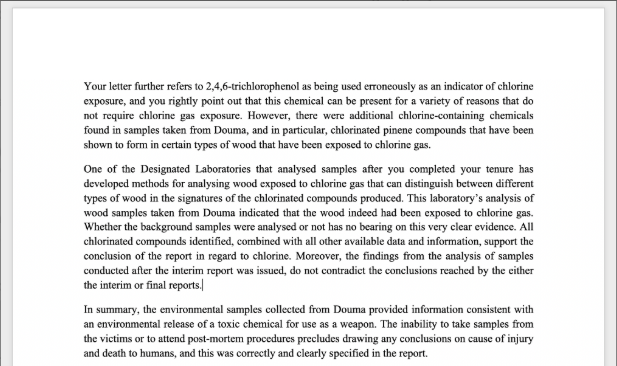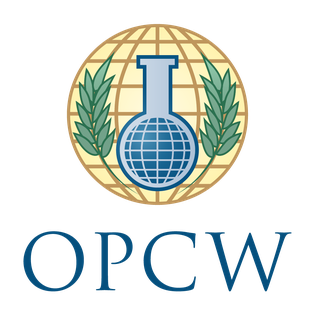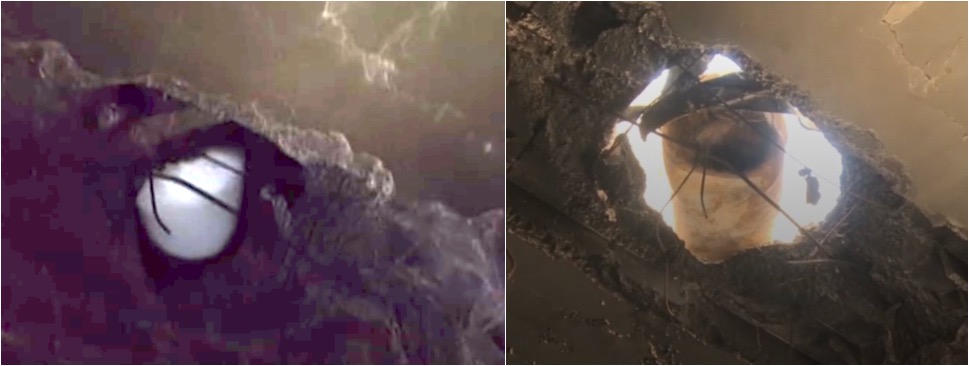Can Ammonia Be Used As A Weapon? Likely Not
In the ongoing conflicts in the Middle East, there have been sporadic reports involving the use of different kinds of industrial chemicals.
In Syria in particular, but also in Iraq, a variety of commentators invariably try to link reports of practically every such instance to use as a chemical weapon, or else use as a precursor for the production of chemical weapons.
When it comes to ammonia, we should ask ourselves this: Is ammonia unusual to the region? Is its use inherently sinister?
History Of Alleged Ammonia Incidents In The Region
Discoveries of ammonia in the Iraq and Syria region are not uncommon and are subsequently hyped in social media.
Reports from Afghanistan are rarer. In 2010, Czech troops in Afghanistan reported a water source was contaminated by ammonia.
In 2014, claims of ammonia use by the Syrian government were not substantially proven by third parties, unlike uses of Sarin and chlorine.
In 2015, a man was arrested in Rochester, New York. He self-identified as an ISIS convert, and had bought household ammonia. It was unclear what he actually intended to do with it.
A January 2016 tweet claimed ammonia was being used in northern Iraq by ISIS in “chemical IEDs.” Around the same time, another report claimed ISIS had used chemical mortar rounds filled with ammonia. In November 2016, numerous reports (here is one example of many) indicated that ISIS was stockpiling ammonia in Mosul. Few details were given at the time.
Most recently, numerous reports of ammonia being captured from ISIS in Hajin have circulated. These reports are based primarily on a video circulated by the Kurdish YPG. This video shows numerous ammonia gas cylinders of Turkish origin.
It should be noted that gas cylinders have been repurposed before in the region, so one cannot actually tell from the video what gas is contained within them. It is plausible that the really do contain ammonia. Fellow Bellingcat contributor Noor Nahas posted some images of these cylinders in a tweet reproduced below. Meanwhile, no relevant reports have emerged from the conflict in Yemen.

Over the years, there have also been some patently false reports. 2013 leaks of ammonia coolant from the International Space Station (ISS) were erroneously tweeted about as having involved ISIS. Various instances of the explosive ammonium nitrate, commonly used in the region, are frequently mis-quoted as “ammonia nitrate,” thus clouding search results for “ammonia.”
What Is Ammonia?
Ammonia (NH3) is a very simple molecule. It contains a single atom of nitrogen and three atoms of hydrogen. It only occurs in small amounts in nature, but is easily synthesized in a number of fairly basic chemical processes dating back to the 18th century.
Ammonia can be produced from the nitrogen in normal air through something known as the Haber-Bosch process, patented in 1910. Fritz Haber is widely regarded as the father of chemical warfare through his later work in use of chlorine and other chemicals. Many would argue that his work on ammonia was of far greater benefit to mankind. He was awarded the 1919 Nobel Prize in Chemistry for the synthesis of ammonia.
Ammonia is a gas at room temperature and it is significantly lighter than air. It is flammable, poisonous, and corrosive. It is notorious as a danger to aquatic life.
Some readers will be familiar with household ammonia either on its own, which is generally only 5% or 10% ammonia, or as a component in many floor and window cleaning products. However, the toxicity and flammability data commonly quoted on things like the Wikipedia page generally refer to purer grades of the product.
Dangers To Humans
As most readers will know, ammonia is extremely irritating to humans. Its smell alone is highly irritating. Fortunately, this also means that it has good “warning properties” in that its pungent smell is present at levels that are much lower than those which are unsafe.
In its purer forms, ammonia is dangerous via skin contact and inhalation. However, its lethal levels are quite high (many thousands of parts per million for long periods) relative to many other poisons. Liquid ammonia can freeze exposed flesh. A full peer-reviewed human toxicology report on ammonia is here.
It should be noted that ammonia is less toxic than it could be to humans as the human body has mechanisms in its metabolism to get rid of ammonia in the bloodstream. In particular, the enzyme carbamoyl phosphate synthetase converts ammonia into another substance for excretion through the urinary tract.
Industrial And Agricultural Uses Of Ammonia
The majority of ammonia production worldwide is used in agriculture. It is used either directly in form of anhydrous ammonia, or to make a variety of nitrogen-bearing compounds, such as the ubiquitous ammonium nitrate.
Other industrial uses are widespread. Many of the numerous useful chemicals containing nitrogen use cheap and easily made ammonia as the source of nitrogen. Hydrazine, hydroxylamine, phenol, acrylonitrile, ethanolamine, ammonium bicarbonate, and urea are only some of the examples of chemicals that can be made from ammonia.
Ammonia is widely known as a cleaning agent, and is well known for its properties as a glass cleaner. Ammonia’s anti-microbial properties allow it to be useful as a disinfectant. It is also used in processes that involve fermentation.
It can be used as a refrigerant, in which context it is known as R717. It was frequently used as such before the advent of chlorofluorocarbons (CFCs) such as “Freon.” It is making a bit of a comeback as a refrigerant now that the environmental hazards of CFCs are well known (example here).
Ammonia is an extremely common industrial chemical and it has such a wide variety of both common and uncommon uses that a full catalogue is beyond the scope of this article. Full explanations of other uses are available online here.
Worldwide annual production of ammonia was estimated at 140 million tons in 2019.
Ammonia is not some kind of exotic imported commodity in the regions of interest. Pre-war Syrian ammonia production was estimated to be 104,000 tons a year. Iraq has more than 300,000 tons per year of ammonia manufacturing. It should be noted that many of these industrial and commercial usages are actually quite low-technology by modern chemical engineering standards. As it can be literally manufactured out of the air using a technique from a century ago, no particular natural resources are needed for ammonia production.
Ammonia Accidents
Because ammonia is widely used in industry and widely transported in such large quantities, it has been involved in a number of industrial and transportation accidents. Some were fairly catastrophic. An infamous incident in May 1976 in Houston Texas, killed five people and injured over 100 when over 7500 of gallons of ammonia leaked. This incident involved a number of contributing factors, and resulted in various recommendations to improve safety and emergency management in the USA.
Most recently, on 25 April 2019, an incident in the Chicago suburb of Beach Park involved two one-tonne containers of ammonia, which leaked. This incident caused the hospitalisation of 37 people, of whom seven were considered to be seriously injured. Residents in the area were evacuated.
Analysing the incident, several points are clear. It involved 2 tonnes of material. Fourteen of the 37 injured were responders who quite possibly could have been better shielded from the effects — modern protective equipment will prevent injury from ammonia. One of the victims saw the vapour cloud and drove into it anyway. Furthermore, the incident was at 4:30 a.m. local time when atmospheric conditions were, apparently, ideal. Pre-dawn hours often have an atmospheric condition called an inversion which makes for ideal conditions for chemical vapours and gases to remain concentrated. Thankfully, nobody died as the result of this incident.
Full emergency management guidelines for ammonia incidents are here. This paper discusses a number of major accidents involving ammonia.
Ammonia’s Potential As A Weapon
Ammonia has been considered a theoretical hazard as a weapon for terrorist use. Consideration as a weapon has, in part, been based on the relatively large number of industrial and transportation accidents involving ammonia. However, the majority of scenarios discussed in this way have involved very large disseminations, truck-load or railway car-sized sources, not battlefield-scale chemical weapons. Even with the large-scale sources involved in the more infamous accidents, fatalities are generally low given the sheer amount of material involved. A rail incident in Minot, North Dakota, released about half a million litres and resulted in one fatality. In this case, the one fatality was a person who disobeyed emergency management directives, fled his home, and drove into the cloud.
Given the toxicity of ammonia, even when pure, and the timescale for deadly exposures to take place (many minutes to an hour), it is simply unrealistic for ammonia to be used in practical warfare in the same way as chlorine or Sarin.
Toxicology and industrial safety studies for ammonia vary widely, but they are all broadly in agreement that ammonia is less deadly to humans than chlorine. Chlorine has been used as a weapon, but only with a very mixed track record. By comparison, ammonia is an even worse warfare agent.
Ammonia’s track record is that it is far more effective at producing irritation or moderate injury rather than fatalities, even when enormous quantities are involved. It could theoretically be used as an irritant, although there are rather a lot of other things that could be used as irritants in a military or paramilitary setting more effectively.
Ammonia does not meet many of the criteria for use as a chemical warfare agent. It is significantly lighter than air, meaning its use in open air as a weapon is problematic unless the source was extremely large. It can burn and has the ability to explode. This makes its use in bursting or exploding-type munitions very problematic. When ammonia is in high concentration, between 15 and 28% of the air, it is within its explosive limits. It should be noted that these are very high concentration levels. Also, ammonia’s distinct smell at levels like 5 parts per million, well below danger levels, means that people can easily flee.
Typical IEDs, artillery shells, and mortar shells do not afford the volume for tactically significant amounts of ammonia to do anything beyond cause a smelly nuisance. Furthermore, many such munitions would destroy much of the ammonia.
Uses of ammonia as a weapon, by regular or irregular forces, are quite rare. An incident in Chechnya in 1999 reputedly saw use of ammonia by Chechen militants, although no particular harm was reported. Ammonia has been used as a corrosive agent for single attacks on individuals. A rash of ammonia attacks causing damage to eyes was reported in Britain in 1988. However, given the amount of ammonia freely available in the world, the case history of its use a weapon is fairly insignificant.
Ammonia’s Role In Chemical Warfare Agent Production
Ammonia has some role as a precursor in the production of certain chemical warfare agents. The so-called Andrussow process and the BMA process for making the chemical warfare agent (and industrial chemical) hydrogen cyanide (HCN) use ammonia. A cruder and more dangerous method, used in the 1890s, passed ammonia over glowing coal.
It should be noted that these are chemical engineering processes used in factory settings and there are easier ways to acquire significant amounts of hydrogen cyanide. Adding acids to commonly available cyanide salts is one way. Other factors are important here as well. Hydrogen cyanide’s use in warfare is dubious, as it is flammable, lighter than air, and has warning properties. It can be very deadly in confined spaces, but its practical record in open air testing as a chemical weapon was poor. Further, there appears to be no record of its use as a weapon anywhere in the current conflict zones.
Ammonia is also used in the production of the nerve agent Tabun. The manufacture of Tabun generally starts with a chemical compound known as dimethylamine. Dimethylamine can be produced from ammonia and methanol, and it was thus produced in Nazi Germany. Tabun manufacture also requires hydrogen cyanide, which can be produced from ammonia as above. However, this is the very beginning of a lengthy process and having ammonia is no indicator of Tabun production, as it is quite far down the supply chain of chemicals and processes needed to make Tabun.
Tabun was manufactured in Iraq during the Iran-Iraq war, but there not been evidence of Tabun usage in the current conflicts.
Other Nefarious Uses
Ammonia is used to produce a number of explosive compounds. Ammonium nitrate, which is extremely common as a fertilizer around the world, is made from ammonia. It is useful as an explosive, particularly when another higher velocity explosive is used to initiate it.
For example, ammonium nitrate was used in the 1995 Oklahoma City bombing. Explosive incidents involving ammonium nitrate in Syria, Iraq, and Afghanistan are commonplace. Ammonium nitrate fertilizer is often smuggled (example) or otherwise diverted for use in making explosive devices in the current conflicts. Ammonia can be reacted with perchloric acid to make ammonium perchlorate, which is useful as a rocket propellant and can be used as an explosive. Ammonia is also used to make nitric acid, which is the starting point for numerous other explosives. Ammonia’s role as a basic building block for numerous explosives is too extensive to discuss in detail here.
Ammonia also has uses in the manufacture of the illegal drug methamphetamine. One method for producing methamphetamine involves a dangerous process which combines ammonia with alkali metals such as lithium. Theft of agricultural anhydrous ammonia, often for methamphetamine production, has been a problem in some rural areas of the United States. Numerous seizures of drugs in the amphetamine family have occurred in Iraq and Syria. Some of the seizures have been from ISIS or their affiliates (example here).
Conclusions
It is unlikely that ammonia is being seriously used as a weapon in the Iraq, Syria, and Afghanistan conflicts. Even though it has some theoretical potential as weapon, credible employment scenarios involve containers and quantities larger than those so far reported in actual incidents. There has been no evidence of the industrial base needed to produce Tabun, nor any evidence of use of Tabun. No hydrogen cyanide weapons or incidents have been reported either. Therefore, it seems unlikely that ammonia is being used as a precursor for chemical warfare agent production.
It seems likely that discoveries of ammonia in Iraq and Syria can be traced back to circumstances unrelated to chemical warfare. Ammonia is normally present in these countries for agricultural and other uses. Its use as a refrigerant in one of the warmest regions on earth is uncontroversial. In itself, it has value on a black market or grey market basis as an agricultural commodity. Furthermore, ammonia has uses in manufacture of explosives and illegal drugs, both of which have been encountered in the region with some frequency.
Bellingcat’s research for this publication was supported by PAX for Peace.



